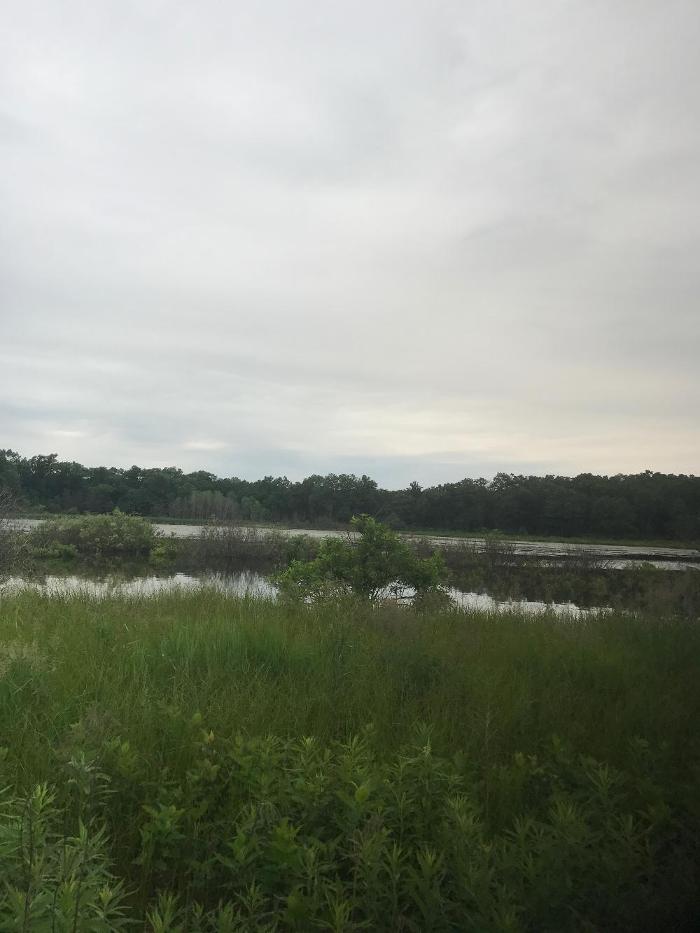Tuesday, Jul 10, 2018
By Abby Pointer, MNA Intern
Tucked away behind an interesting little trucking company, Five Lakes Muskegon Nature Sanctuary is a true sanctuary. A hidden, untouched, and thriving ecosystem where you would least expect it. In June, the Michigan Nature Association held a scheduled workday dedicated to the upkeep of this sanctuary. Five Lakes Nature Sanctuary consists of rare habitat, composed mostly of coastal plain marsh. I was told by the stewardship coordinator, Sam, that some of the plants found in the sanctuary are isolated communities that are typically found in marshes on the Atlantic coast. Thinking about the ecological reason as to how these plants managed to find a home in Michigan makes protecting these rare communities all the more important.

Invasive spotted knapweed
The nature sanctuary not only contains coastal plain marsh, but also other critical habitats such as oak-pine barrens and dry sand prairies. The reason for our workday was focused on preservation of the dry sand prairies, which are susceptible to invasive species such as spotted knapweed. This invasive plant thrives in the soft, sandy soil. Spotted knapweed uses allelopathic chemicals to inhibit surrounding plant growth by exuding the chemical from its roots. For the critical habitat that the Five Lakes Nature Sanctuary protects, allowing this invasive species to spread would be detrimental to the rare marsh plant and wildflower communities.
The workday was led by West Michigan Regional Stewardship Organizer, Sam Brodley, and was attended by the two stewards of the sanctuary. What was unique about the stewards was that they were both young teenage girls. It was cool for me, as an aspiring female conservation biologist, to see young girls actively engaged in natural resource management. My mom and I arrived at the work day a little late, so we missed the group heading to the work site. Not knowing which direction they headed, we ended up going on a bit of a walk in the opposite way. While we missed some of the actual work, we were able to explore some of the sanctuary that we otherwise wouldn’t have seen. The trail we were on followed the marsh area and ran deeper into the woods as opposed to the dry sand prairie that we hoped to find. Though we enjoyed the scenic detour, I eventually contacted Sam and found our way to the right place.
The area we were working in was an open area, with sparse trees and shrubbery. Nothing stood out to me at first as clearly invasive, as sometimes plants do when they begin to overtake an area. One of the women who attended the workday told me that once you know what spotted knapweed looked like, you’d see it everywhere. She was very correct. It took me a second to become familiar with the plant, but soon I could spot it amongst other prairie like plants. The plant has a pale green, ashy complexion, which makes it stand out against native species. We were also told to look for its compound leaves to help distinguish it from similar prairie plants. Since the soil was so loose and it had recently rained, it was easy to pull the entire plant, taproot included, from the ground. We were lucky that the knapweed had not flowered yet, so we didn’t have to worry about bagging or burning the discarded plants.
When we had felt like we had made solid progress, we made the walk back to the cars and parted ways. Attending a workday, though shortened by an unfortunate case of misdirection, was a great way to feel involved with the nature of Michigan, even in places you’d least expect it. I got a great breathe of fresh air, and now I will always know how to spot spotted knapweed!
Check out MNA’s event calendar for find a volunteer workday near you!


